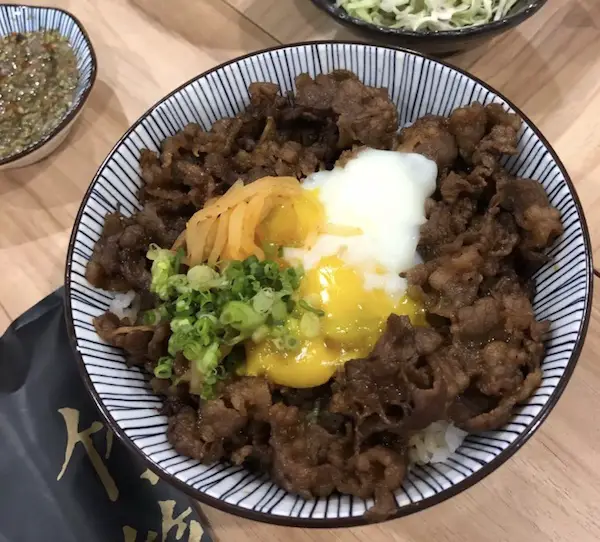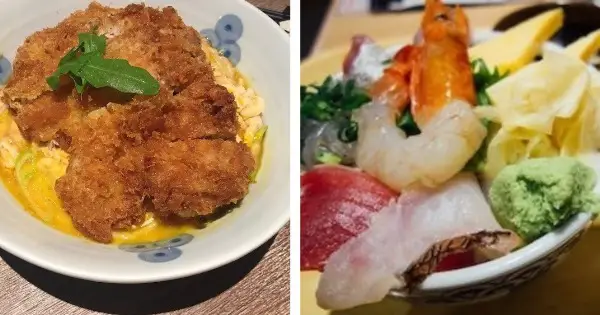We are reader supported. When you purchase through links on our site, we may earn an affiliate commission. Also, as an Amazon affiliate, we earn from qualifying purchases.

When I am too hungry to wait for sushi rolls and want to feel fuller, my go-to food is the sushi bowl, also known as Chirashi. The order comes quickly when I am dining out and can be prepared in a few minutes if there are leftover ingredients from a sushi dinner.
There another type of one-bowl dish, which is also my favorite and it is called Donburi. It is served in a ceramic bowl and there are different variations of Donburi based on the type of toppings used. Both Chirashi and Donburi are my favorites because they can be put together quickly to make a filling lunch or dinner.
Despite the basic similarities between the two, there are several fine differences between Chirashi and Donburi that make these Japanese delicacies unique. In today’s article, I will look closer into the intricate details of the composition, ingredients, and presentation of these dishes.
| Chirashi | Donburi | |
| Meaning in English | Scattered Bowl | Japanese rice bowl dish |
| Bottom part | Contains vinegared rice | Contains plain rice |
| Other ingredients | Rice may be mixed with toasted sesame seeds or finely chopped vegetables | Rice may be brushed with unagi sauce or other soy-based sauces. |
| Different Varieties | 3 main varieties | over 18 varieties of Donburi |
| Types of toppings | Mostly contains raw fish, seafood vegetable toppings artfully decorated on the top | Mostly contains cooked meat, eel, and vegetable toppings. Raw fish and seafood is a part of Kaisendon |
| Cost | Relatively cheaper than sushi rolls or nigiri | Expensive due to the type of toppings used |
Chirashi: The Bright And Colorful Sushi Bowl
Chirashi Sushi can be roughly translated as ‘scattered sushi’ in English, and it is usually served on happy and festive occasions in Japan. This bright and colorful dish has vinegared sushi rice at the bottom and the toppings may range from sashimi-style raw fish and seafood to vegetables and fruits. The dish may be garnished with finely chopped scallions, fish roe, and toasted sesame seeds.
There are 3 main types of Chirashi Sushi based on the different styles of preparation. They are Edomae chirashizushi, Gomokuzushi, and Sake-zushi. The common ingredient in all these three variations is the vinegared sushi rice. Toppings, fillings, and condiments may vary widely. Let’s take a look at the three different styles of chirashizushi
Edomae chirashizushi
Often referred to as the Edo-style scattered sushi, this type of chirashizushi is what most people are familiar with. The sushi bowl you get at Japanese restaurants outside Japan typically follows this style. It has a bright and assorted sashimi slices over a layer of vinegared sushi rice.
The sushi chefs in the Edo period started preparing this style of sushi around the early 1990s, and since then it came to be known as Edomae chirashizushi. Although the dish has highly evolved since the Edo period, it still primarily composes of raw toppings in an artful arrangement
Kansai-style sushi (Gomokuzushi )
This style of sushi is known as Gomoku zushi or Bara Sushi depending on the regional influences in the style of preparation. It contains cooked vegetables, fish or seafood on a bed of vinegared rice. If you order a chirashi sushi in Japan, you will get this dish with traditional ingredients like lotus root, gobo, and kanpyo.
It may be difficult to find the traditional toppings outside Japan but you may still try at an Asian grocery store near you. The sushi rice may also be mixed with ingredients such as blanched Bamboo shoots, finely chopped Inari Age, fish cakes, and seasoned dehydrated tofu. Common toppings are avocado, imitation crabmeat, blanched green beans, and flying fish roe.
Kyushu-style sushi
Also known as Sake-zushi in Japanese, this style of chirashi uses rice wine or sake instead of vinegar while preparing sushi rice. The toppings include a mix of vegetables and cooked seafood such as sea bream, shrimp tempura, shiitake mushrooms, shredded omelet, boiled octopus, and bamboo shoots.
Donburi: Japanese Rice Bowl Dish
Donburi is a Japanese term that can be roughly translated to ‘bowl’ and it is often abbreviated as ‘don’. This traditional delicacy constitutes of vegetables, meat, fish or other ingredients that are simmered on low heat and served over plain rice. The meals are typically served in large size ceramic bowls, hence they are very filling.
Donburi may sometimes be referred to as savory or sweet stews on cooked rice. The sauce used for simmering varies widely based on ingredients, season, region, and taste. It is primarily dashi, often flavored with mirin and soy sauce. The proportions may vary but dashi is always on the higher side.
One of the biggest differences between chirashi sushi and donburi is that the former uses vinegared sushi rice but the later uses plain rice. The traditional donburi typically consists of cooked toppings such as grilled eel, pork cutlets and so on. There are over 15 different varieties of this delicacy, but I will mention the most popular ones here.
Unadon (Unagi donburi)
If you love eating eel then you are sure to love this dish too. It primarily consists of Unagi or freshwater eel over a bed of cooked rice served in a bowl. The eel is cooked or grilled with sweetened soy sauce and dashi. It is one of the most expensive dishes because unagi is rare to find delicacy. If you ever visit Japan, you must include eating Unadon in your list of things to do.
Tendon (Tempura Donburi)
This is the short form for tempura donburi, mainly consisting of fried ingredients over a bed of plain rice. If the mention of tempura gives you the vision of delicious breaded and fried shrimp then you may be mistaken. In Japan, tempura is used not only to refer to deep-fried shrimps, but also for other seafood and vegetables like sweet potato, okra, pumpkin, and so on.
Kaisendon (Sashimi On Rice)
I am a big fan of Kaisendon, especially for its close resemblance to sashimi and sushi. It is made of a bowl of cooked rice with delicious raw fish and seafood toppings. The most popular ingredients used in the dish are tuna, ikura, crab, squid, sea urchin and so on. If you order Kaisendon in a Japanese restaurant, be prepared to shell out a good amount of money because sushi-grade fish does not come cheap.
Katsudon (Fried Pork Cutlets On Rice)

Katsu refers to breaded and deep-fried pork cutlets, a rich delicacy found in Japan and the ‘don’ obviously refers to bowl. There’s an interesting Japanese tradition according to which the students should eat this dish the night before any test at school because ‘Katsu’ means ‘to win’ in English. I don’t know how much that logic works but I can say that this dish is super delicious and a must-try!
Gyudon (Beef Donburi)

‘Gyu’ is the Japanese term for beef, so gyudon refers to a beef bowl. It is made up of rice at the bottom and beef simmered in soy sauce. It may include onions and raw eggs on the top. In Japan, people like eating this dish with pickled ginger or gari. As this is a popular delicacy in Japan, you can find it in almost every Japanese restaurant.
Easy Homemade Chirashi And Donburi
Now, that I have told you about the difference between chirashi and donburi, and also discussed the different varieties you can find at the restaurants, here are some quick recipes. Both the dishes are easy to make, depending on what ingredients you use, so let’s take a look.
Chirashizushi Recipe
What you will need:
- 2 cups of seasoned sushi rice
- ¼ cup sushi-grade tuna, cut into bite-size pieces
- ¼ cup sushi-grade salmon, cut into bite-size pieces
- ¼ cup boiled octopus, cut into bite-size pieces
- 2 shiitake mushrooms, finely sliced and marinated in ponzu sauce
- 2 eggs, hard-boiled
- 1 umeboshi plum, seed removed and finely chopped
- Scallion, finely chopped
- 3 tablespoon tobiko
- 2 fresh shiso leaves
- soy sauce and ponzu
Use short-grain Japanese sushi rice to prepare the rice and when it cools, season it with a mixture of vinegar, sugar, and salt following the instructions mentioned in this article.
You can arrange chirashi in two ways – layer vinegared rice at the bottom part of a bowl and add the toppings over it (restaurant-style) or mix the rice evenly with the ingredients and then divide it into equal portions (quick home-made style). Drizzle some soy sauce over the toppings and serve.
Unadon (Unagi Don) Donburi Recipe
What you will need:
- 2 cups of cooked rice
- Unagi (eel) fillets
- Japanese sansho pepper
- Unagi Sauce (Tare)
- ¼ cup soy sauce or tamari
- 1½ tbsp sake
- ¼ cup mirin
- 2½ tbsp sugar
To make donburi, you will need to cook rice and short-grain rice works best. The only difference is that there is no seasoning required.
Prepare unagi sauce by mixing mirin, sake, and sugar in a saucepan. Place the pan on medium heat and stir all the mixture. Add soy sauce and simmer on low heat for 20 minutes. You can see more bubbles when the sauce is ready. You can now use this sauce for preparing eel and store the rest in the fridge.
Preheat the oven to 550F for about 3 minutes. While the oven gets ready, cut the eel in half or smaller to fit inside the bowl. Cover the baking sheet with aluminum foil and brush some oil slightly on it. Keep the unagi slices on the top and broil for 5-7 minutes.
After 7 minutes, take it out and brush some unagi sauce on the fish. Broil again for 30-60 seconds, or until you see a lot of bubbles forming.
To assemble everything together, first add plain rice to the serving bowl, brush a little unagi sauce on the rice. Put the broiled eels on the rice and brush some more eel sauce on it. Serve immediately.
Related Questions
Can I make a vegetable-only chirashi and donburi?
Yes, you may use vegetables and fruits like carrots, scallions, asparagus, onions, sweet potato, bell pepper, cucumber, avocado, mango, strawberry, and so on. While you may use raw vegetables on chirashi, grill them with soy sauce or eel sauce for donburi.
Is donburi gluten-free?
No, it is not but you can tell the chef to make gluten-free donburi by making a bowl dish containing rice and tuna, without any sauce. If using sauces, make sure it is tamari, the gluten-free soy sauce.
See Also:
Is Japanese Ramen Healthy
What Does Takoyaki Taste Like?
How Much Is Wagyu Beef?

